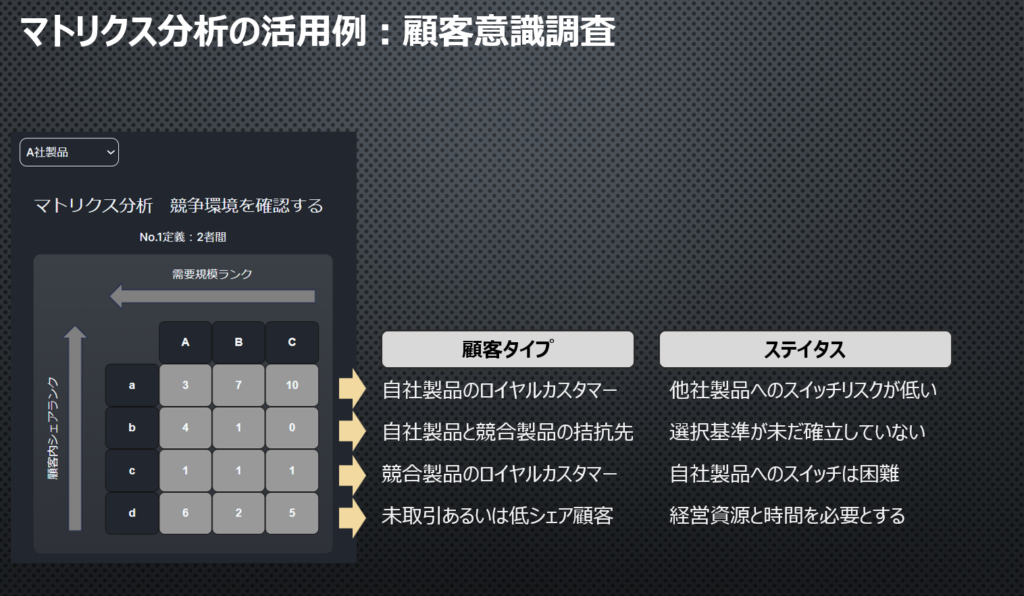
競合製品が適応症を追加することになり、MRが各10人の医師から反応を調査することになりました。
対象医師数は46Drですが、さてどのように10人を選定すれば良いでしょうか?
私がMRだったら、Caフレームの顧客からヒアリングを行います。
なぜならMRにとってヒアリングの作業は本業務ではなく、売上に直結するものではないからです。
Caフレームの顧客は、自社製品のロイヤルカスタマーですが、患者数と競合製品の採用数が少ない顧客だからです。
つまり面会しやすく話もしやすいため、ヒアリングをしやすい顧客といえます。
さっさとヒアリングを片付け通常業務に戻ります。
一方で、データ分析を行う者からすれば、このようなバイアスがかかったデータからは正確な結果を導き出すことは不可能でしょう。
ではどうすればバイアスの無いデータを収集することが出来るでしょうか?
それはヒアリングを行う顧客の背景を揃えて収集することです。
私が分析者なら、b行の顧客からヒアリングを行います。
b行の顧客は自社製品の競合製品の拮抗する顧客であり、薬剤の選択基準が未だ確立していないからです。
競合製品の適応症の追加が、今後の薬剤選択にどのような影響を及ぼすか予め把握し、先手を打つ必要があります。
a行の顧客は自社製品のロイヤルカスタマーでありスイッチの可能性は高くありません。
またc行の顧客は競合製品のロイヤルカスタマーであり、適応症追加が追い風になることは容易に予想されます。
市場調査を行う場合には、目的とそのために必要なデータを実施者に明確に指示し、解像度を高めることが重要です。
Utilizing Matrix Analysis: A Case Study – Customer Awareness Survey
As competing products are expanding their indications,MRs are tasked with gathering feedback from 10 physicians each.
While the target pool consists of 46 doctors, the question arises: how should these 10 individuals be selected?
If I were an MR, I would prioritize conducting interviews with customers in the “Ca” category. This is because, for MRs, conducting interviews is not their primary task, and it doesn’t directly impact sales.
Customers in the “Ca” category are loyal customers of our own products, but they have a lower patient population and fewer adopters of competing products. This makes them easily accessible and more likely to engage in conversations, making them ideal interviewees.
After swiftly conducting interviews, I would return to my regular duties.
However, from the perspective of a data analyst, it would be impossible to derive accurate results from data skewed by such biases. So, how can we collect unbiased data?
The solution lies in aligning the backgrounds of the customers being interviewed.
If I were an analyst, I would conduct interviews with customers in the “b” category. These customers are those who have competing products as alternatives, and their criteria for choosing medications have not yet been firmly established.
Understanding the potential impact of the addition of indications for competing products on future medication choices is crucial. It allows us to take proactive measures.
Customers in the “a” category are loyal customers of our products, and the likelihood of them switching is low. On the other hand, customers in the “c” category are loyal customers of competing products, and it’s easily anticipated that the addition of indications will work in our favor.
When conducting market research, it’s crucial to clearly instruct the researchers on the purpose and the required data to increase resolution and accuracy.

